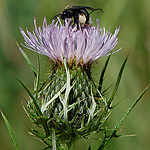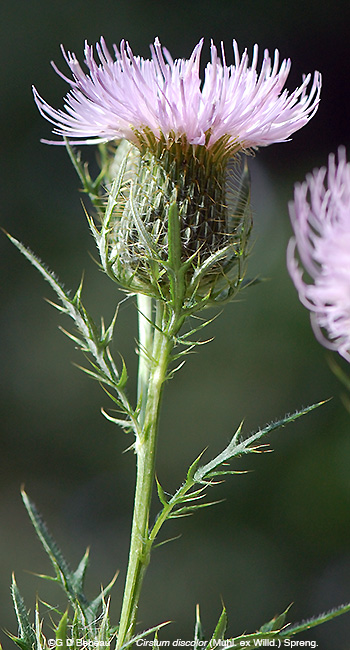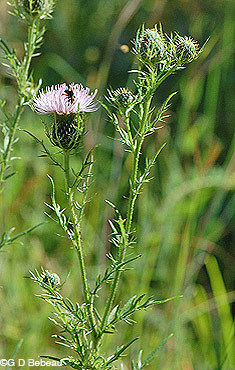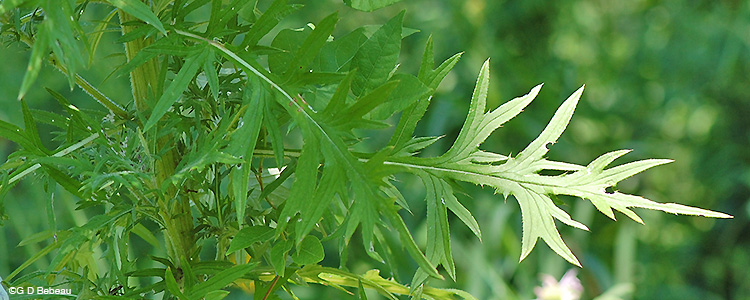The Friends of the Wildflower Garden, Inc.
Plants of the Eloise Butler Wildflower Garden
The oldest public wildflower garden in the United States

Common Name
Field Thistle
Scientific Name
Cirsium discolor (Muhl. ex Willd.) Spreng.
Plant Family
Aster (Asteraceae)
Garden Location
Upland
Prime Season
Late Summer
Most people don't grow thistles as ornamentals but you have to admit the flower is nice and is very attractive to bees and butterflies.
Stems: Plants can reach up to 7 feet in height with erect lateral branching. Stems are light green and have white hair when young giving the plant an overall silvery appearance. The plant is usually biennial, forming a basal rosette the first year and sending up the tall stem the second year.
Leaves: Leaves are alternate, pinnately divided (usually more than halfway to the mid-veins), spiny on the margins but not on the upper surface, and large - up to 9 inches long. The more basal leaves are the largest but these are usually dropped by flowering time. The upper side is dark green and the under appears whitish due to many fine hair - which lead to the species name of discolor. Leaves are sparse at the top of the stem and do not crowd the flower heads.
The floral array consists of single stalked flower heads or small clusters of stalked heads in a corymb or panicle type array, all rising on erect stems branching from the top of the plant.
Flowers: The flower heads are up to 1 1/2 inches wide and are densely filled with small 5 lobed disc florets that have pink to purple corollas (rarely white) rising from a tubular base with the corolla noticeably longer than the tube and the throat of the corolla noticeably wider than the tube. Florets are bisexual. Each has 5 stamens that surround the single style, which is exserted from the corolla throat when the floret opens. The outside of the flower head has 10 to 12 series of phyllaries that look like fish scales, are lighter green in color with a white central stripe (a glutinous ridge). The outer and middle phyllaries are appressed to the flower head. The outside of the head is very prickly as each phyllary has a single slender spine 3 to 9 mm long. At the very base of the head are a set of floral bracts that look like ascending miniature leaves embracing the flower head. Flowers do not have a fragrance.
Seed: The flowers mature to a dry 4 to 5 mm cypsela that has attached some brownish to tan fuzzy pappus for wind dispersion. The pappus is 18 to 25 mm long and is shorter than the corolla itself.
Habitat: Field Thistle prefers full sun with medium moisture in loamy soils - a typical open field environment. It grows from a tap root with coarse fibrous laterals that do not have tuberous enlargements. It does not spread vegetatively but re-seeds by wind dispersion of the seeds. The flowers provide an attraction for bees and butterflies and the seeds are preferred by the American Goldfinch. See Eloise Butler's notes below. C. discolor will hybridize with C. altissimum and C. muticum, the latter present in Minnesota.
Names: An older scientific name for the plant is Carduus discolor. The genus Cirsium is from the Greek word kirsion - for a particular thistle and has been adopted for a number of plants generally not appreciated by gardeners. The species discolor means 'of two different colors' (usually distinct colors), referring to the upper and underside leaf color of this species. The authorship of the plant classification is complex. The species was described by ‘Muhl’ who is Gotthilf Heinrich Ernst Muhlenberg (1753-1815) American Botanist who produced several catalogs of plants after retiring as a Lutheran pastor. His work was not complete and was corrected and republished by ‘Willd.’ who is Carl Ludwig Willdenow (1765-1812), German botanist, a founder of the study of the geographic distribution of plants. He was director and curator of the Botanic Garden of Berlin. That work was further updated by ‘Spreng.’ who is Kurt Polycarp Joachim Sprengel (1766-1833) German botanist who is noted for his early studies of the fertilization of flowers by insects.
Comparisons: Here is a comparison sheet of the 7 thistles found in Minnesota.


Above: The flower heads of Field Thistle are well liked by pollinators and then the Goldfinches later in the season. Drawing from Britton, N.L., and A. Brown. 1913. An illustrated flora of the northern United States, Canada and the British Possessions. 3 vols. Charles Scribner's Sons, New York.
Below: Field thistle usually has single flower heads or small clusters on stems branching from the top of the plant. Heads are about 1-1/2 inch wide with pinkish-purplish tubular disc florets. The small leaf-like appendages ascending from directly under the head and embracing it are actually bracts and not true leaves. The plant can be quite large and tall.



Below: 1st photo - On this flower bud you can see the fish-scale-like floral phyllaries with a vertical white stripe and each with a yellow spine projecting. 2nd photo - Each seed has fine tan to brownish pappus attached for wind dispersion.


Below: The lower stem leaves are up to 9 inches long, lobes cut almost to the central rib, spines on the margins.

Notes: Eloise Butler had catalogued four thistles in her plant index as present in the Garden area. Field Thistle was one of them. She also noted planting one in 1918. It was also listed on Martha Crone's 1951 inventory of plants in the Garden at that time. Field Thistle is native to Minnesota in a band of counties running from the SE corner to the NW, plus Lake County. In North America it is found in the eastern half of the continent, Florida and the Canadian maritime provinces excepted. In a few states, such as Iowa and Arkansas, it is classified as a noxious weed but in comparison to the noxious qualities of C. vulgare and C. arvense it is in the junior league.
Eloise Butler wrote about Thistles: "The Scotch made no mistake in selecting the thistle for their national flower. Bristling with needle-like prickles, a type of stern independence, it does not admit of close intimacy. But we are captivated by its reddish purple blooms, fragrant as roses [Ed: But not the Field Thistle] and brimmed with sweetness. Economical and thrifty, the thistle can wrest a living from the scantiest means; but “ower canny” as it is, it sends out myriads of plumy seeds, by which it will establish itself in richer soil whenever the opportunity offers. The voracious caterpillar crawls by it to plants with unarmed herbage; the thistle is browsed only by underfed donkeys. It is often decked with winged visitants of black and gold, the thistle birds or goldfinches, surrounded by drifting clouds of silvery plumes, as they lightly swing on the matured flower heads and eagerly break them apart to obtain their favorite food. The buds, the beautiful flower clusters, the feathery balls of fruit, and the deeply lobed leaves with ruffled margins of the thistle, all readily lend themselves to designs for ornament."
"The Field Thistle, Cirsium discolor, is particularly lovely by reason of its pale pink, or sometimes white flowers, and long, drooping leaves. The bull thistle [Cirsium vulgare] has larger heads and still more formidable prickles; while the tall swamp thistle is less stout and spiny. [C. muticum Michx.]. These species are not undesirable for a garden, if one has space enough to keep them at arm’s length. But no good word can be said for the Canada Thistle, an emigrant from Europe that multiplies apace, although allowed no rights of citizenship. It seems useless to legislate against it; for it has a running root stock that spreads while we sleep, and the seeds fly over the country to sow discomfort everywhere. It is a pest because it is so difficult to keep within bounds. If you wish to know just how Theophilus Thistlewaite thrust three thousand thistles through the thick of his thumb (too low an estimate by far!), clear by hand a plot of land that has been overrun by Canada Thistles." Published August 27, 1911, Minneapolis Sunday Tribune
Return to -- Site Plan/Archive Index --or-- List of Common Plant Names -- or -- List of Scientific Names -- or --Home Page - - - Back to top.
References: Plant characteristics are generally from sources 1A, 32, W2, W3, W7 & W8 plus others as specifically applied. Distribution principally from W1, W2 and 28C. Planting history generally from 1, 4 & 4a. Other sources by specific reference. See Reference List for details.
 Identification booklet for most of the flowering forbs and small flowering shrubs of the Eloise Butler Wildflower Garden. Details Here.
Identification booklet for most of the flowering forbs and small flowering shrubs of the Eloise Butler Wildflower Garden. Details Here.
©2015
Friends of the Wildflower Garden, Inc. Text and photos are by G. D. Bebeau unless otherwise credited. "www.friendsofeloisebutler.org"
041820